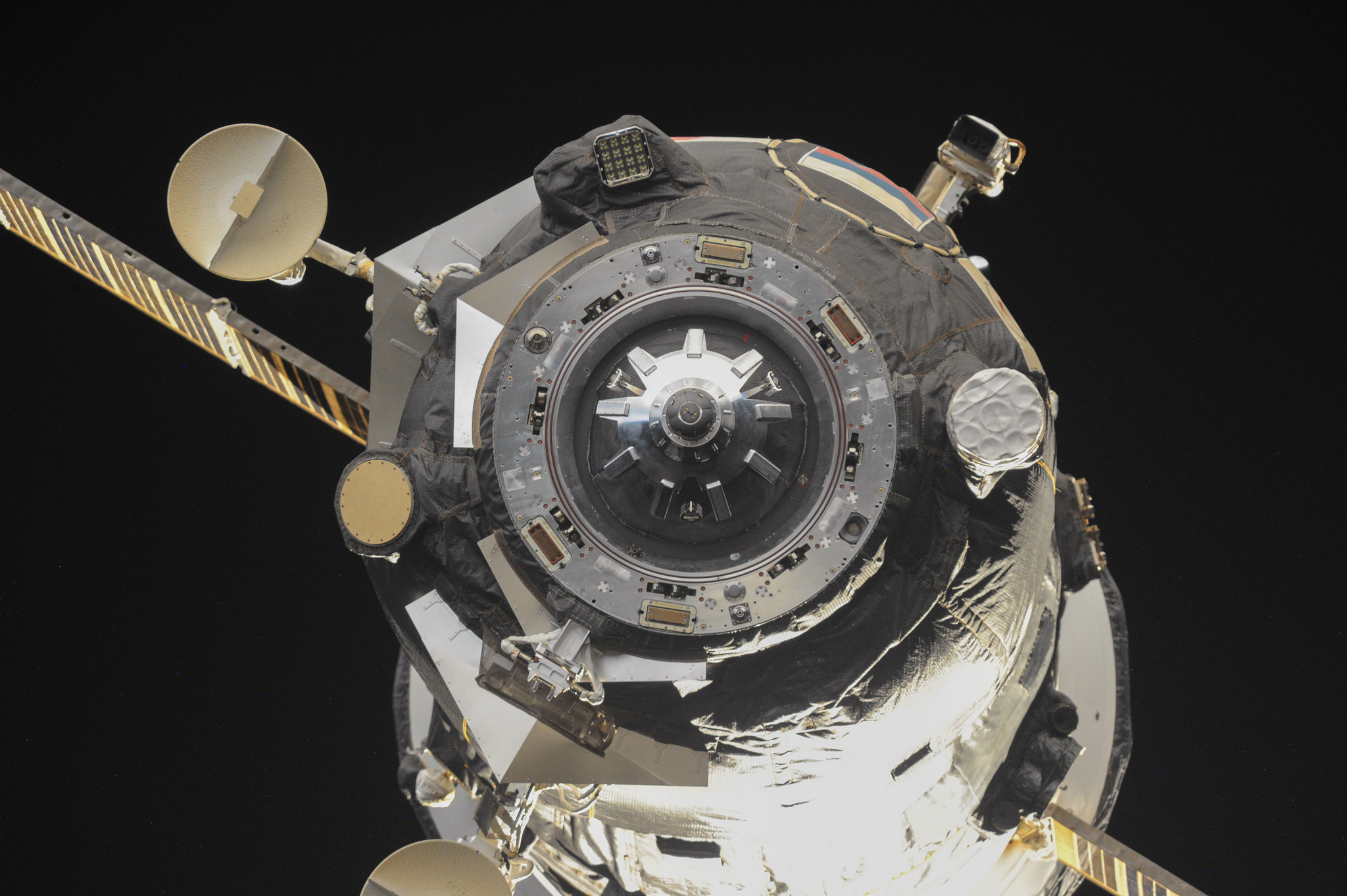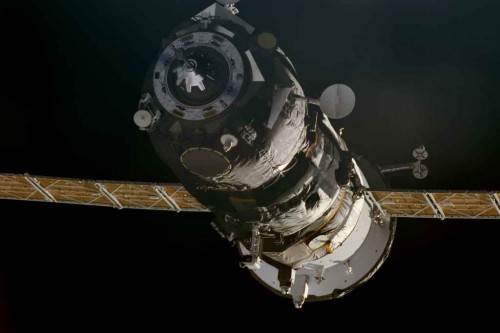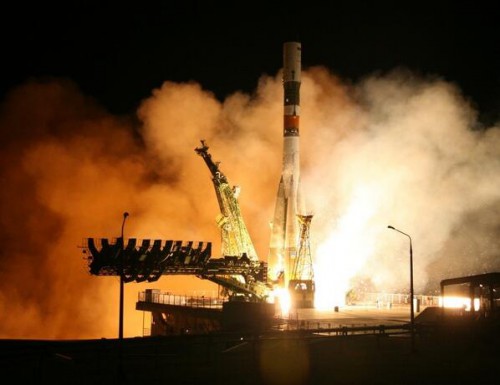
After three months docked at the International Space Station (ISS), Russia’s Progress M-23M cargo craft—otherwise known as “Progress 55P” in ISS Program-speak—successfully separated from the orbital outpost at 5:44 p.m. EDT yesterday (Monday), bound for several days of “Radar Progress” experiments and ultimately a fiery destruction in Earth’s upper atmosphere on 1 August. In the meantime, its successor, Progress M-24M (or “Progress 56P”), encapsulated within the payload shroud of a mammoth Soyuz-U booster, was rolled out to Site 1/5 at the Baikonur Cosmodrome in Kazakhstan early Tuesday, preparatory to its own launch at 3:44 a.m. local time Thursday (5:44 p.m. EDT Wednesday). Following a well-trodden “fast rendezvous” path, first trialed in August 2012, it is anticipated that Progress M-24M will dock automatically at the Earth-facing (or “nadir”) port of the station’s Pirs module at 9:30 a.m. Baikonur time Thursday (11:30 p.m. EDT Wednesday), a little less than six hours after liftoff.
This will be the third Progress resupply mission of 2014, following the launches of Progress M-22M in February and Progress M-23M in April. The spacecraft, which can trace its ancestry back to the mid-1970s, was delivered to Baikonur by manufacturer RSC Energia on 18 February to begin final processing. Over the next few weeks, Progress M-24M sailed through checks of its myriad systems and underwent vacuum tests to confirm its structural and pressure integrity. After a brief spell in storage, processing resumed in earnest in June and earlier this month the State Commission issued formal authorization to begin fueling Progress M-24M’s main propulsion and attitude-control systems with nitrogen tetroxide and unsymmetrical dimethyl hydrazine in the Spacecraft Assembly and Testing Facility. It was then encapsulated within the Soyuz-U payload shroud.
According to Spaceflight101, Progress M-24M will transport approximately 5,500 pounds (2,500 kg) of cargo and equipment to the station’s six-man Expedition 40 crew—which consists of Russian cosmonauts Aleksandr Skvortsov, Oleg Artemyev and Maksim Surayev, U.S. astronaut Reid Wiseman and Germany’s Alexander Gerst, under the command of U.S. astronaut Steve Swanson—and will remain attached to the ISS until late October. The cargo includes food, maintenance hardware for the Russian Orbital Segment (ROS), personal crew items and general supplies. “Science delivered by Progress M-24M includes a habitat with up to 25 snails that are set for a stint aboard the space station,” it was explained, “as part of the Regeneration-1 study that looks at morphological and physiological changes in prolonged exposure to microgravity.”

Meanwhile, aboard the ISS, Progress M-23M spent its last days in orbit being loaded with unneeded gear and trash and Skvortsov, Artemyev and Surayev activated its systems, removed sensors and air ducts and readied it for departure. Its docking mechanism was installed on Sunday and hatches between the spacecraft and the Pirs module—which is utilized both as a docking port and an EVA airlock—were closed. Early Monday, Progress M-23M was electrically disconnected from the station’s utilities and the undocking command was issued about 90 seconds prior to physical separation. This command initiated the opening of hooks and latches and the two spacecraft parted company at 5:44 p.m. EDT, with Progress M-23M heading for a destructive plunge into the atmosphere on 1 August.
Prior to its “Viking funeral”, however, from 26-31 July, Progress M-23M will participate in five days of “Radar Progress” experiments. These seek to examine the density, size and reflectivity of the ionospheric environment around the spacecraft. First performed back in 2010, the experiment will involve Progress M-23M performing a number of thruster firings into the local plasma and these will be tracked by instruments at the Institute of Solar-Terrestrial Physics Siberian Branch of the Russian Academy of Sciences in Irkutsk.
With the former occupant of Pirs thus gone, preparations entered their final stages to deliver Progress M-24M into orbit. The Soyuz-U booster—a direct descendent of Chief Designer Sergei Korolev’s R-7 intercontinental ballistic missile—and its precious cargo were rolled horizontally out to Baikonur’s Site 1/5 and raised to the vertical. Electrical and propellant umbilicals were connected as technicians started battery charging and fueling. The process of loading liquid oxygen and rocket-grade kerosene (known as “RP-1”) aboard the Soyuz-U is expected to commence about five hours before tomorrow’s liftoff, after which the vehicle will transition to a “topping” mode, whereby all cryogenic boil-off propellants will be rapidly replenished until close to launch time. This ensures that the liquid oxygen tanks are maintained at Flight Ready levels, ahead of the ignition of the Soyuz-U’s single RD-118 first stage engine and the RD-117 engines of its four tapering strap-on boosters.
Internal avionics will be initiated and the on-board flight recorders will be spooled-up to monitor the rocket’s systems during ascent. At T-10 seconds, the turbopumps on the core and strap-on boosters will come to life. Following confirmation that the engines are all burning at full power, the fueling tower will be retracted and Progress M-24M will roar into the darkened Baikonur sky, turning night into day across the desolate Kazakh steppe.
Rising rapidly, the vehicle will pass 1,100 mph (1,770 km/h) within a minute of liftoff, during which time the maximum amount of aerodynamic stress (known as “Max Q”) is expected to impact its airframe. At T+118 seconds, at an altitude of about 28 miles (45 km), the four strap-on boosters will exhaust their supply of liquid oxygen and RP-1 and will be jettisoned, leaving the central core and its single engine to continue the ascent. By two minutes into the flight, the rocket will be traveling at over 3,350 mph (5,390 km/h). The payload shroud and escape tower will be discarded shortly afterward, and, some four minutes and 50 seconds after leaving Baikonur, the core stage will separate at an altitude of 105 miles (170 km) and the RD-0110 engine of the third stage will ignite to boost Progress M-24M to a velocity in excess of 13,420 mph (21,600 km/h). By the point of third stage separation, about nine minutes into the flight, the vehicle will be in space.

Separation of Progress M-24M from the final stage of the launch vehicle is expected to take place into a target orbit of approximately 120 x 152 miles (193 x 245 km), inclined 51.6 degrees to the equator. Shortly afterward, the process of unfurling its solar arrays and Kurs (“Course”) rendezvous and navigation appendages will get underway. Two maneuvering “burns” will be performed during the craft’s first orbit of Earth, followed by two more burns on the second orbit, which will serve to establish the proper conditions for an automated rendezvous and docking at the space station.
If the mission launches on time, and docks with the ISS on time, Progress M-24M will secure one of the shortest intervals between a visiting vehicle departing Earth and arriving at the station: just five hours and 46 minutes. To place this into context, of the five previous Progresses which successfully executed fast-rendezvous profiles since August 2012, the current record is held by Progress M-20M, which reached the ISS in just five hours and 41 minutes. In terms of the five piloted Soyuz spacecraft which have followed the minimum-duration rendezvous profile since March 2013, the current record is held by the crew of Soyuz TMA-09M, who docked at the ISS just five hours and 39 minutes after their launch in May 2013. Progress M-24M will remain attached to the station until the fall, with undocking and departure presently anticipated on 27 October.
The Progress program has a storied history. Its development began in 1973 in response to the anticipated problem of resupplying and refueling the Soviet Union’s Salyut 6 space station, whose cosmonauts went on to spend more than six months at a time in orbit. Modeled closely on the Soyuz spacecraft, its interior was redesigned to house foodstuffs, water, experiments, and fuel for the station’s maneuvering thrusters. Since its maiden voyage, Progress has seen many changes, but its role has remained largely unchanged … and the numbers speak for themselves. Between its first launch in January 1978 and tomorrow’s flight, no fewer than 145 Progresses have roared aloft. Only one has failed to reach its destination: the unlucky Progress M-12M in August 2011, whose launch vehicle suffered an engine malfunction and re-entered the atmosphere over the Altai region.
Writing in 1998, astronaut Jerry Linenger—one of the handful of U.S. astronauts to reside aboard Russia’s Mir space station—recounted the sheer joy of receiving a shoebox full of goodies from his wife and children: “Once found, and munching on fresh apples that had also arrived in the Progress,” he described in his memoir, Off the Planet, “we individually retreated from our work and sneaked off to private sections of the space station, eager to peruse the box’s contents.” Fellow astronaut John Blaha once described similar excitement: “Once we found our packages,” he wrote, “it was like Christmas and your birthday, all rolled together, when you are five years old. We really had a lot of fun reading mail, laughing, opening presents, eating fresh tomatoes and cheese.” In more recent times, ISS crew members have done much the same. In February 2008, Peggy Whitson, commander of Expedition 16, remembered crewmate Dan Tani calling one Progress “the onion express,” as the latest delivery of letters from home and fresh foodstuffs arrived.
In their book Soyuz: A Universal Spacecraft, David Shayler and the late Rex Hall speculated that the term “Progress” may have originated from the implication of having made significant progress in space station operations, although the precise heritage of the name remains unclear. What is clear, though, is that aside from the technical and functional role of Progress over the decades, it has provided an indispensable psychological crutch for dozens of cosmonauts and astronauts—a crutch which has enabled them to overcome the profound isolation of the strange microgravity environment, far from family and friends.
– Want to keep up-to-date with all things space? Be sure to “Like” AmericaSpace on Facebook and follow us on Twitter: @AmericaSpace
Missions » Progress » M-24M »



